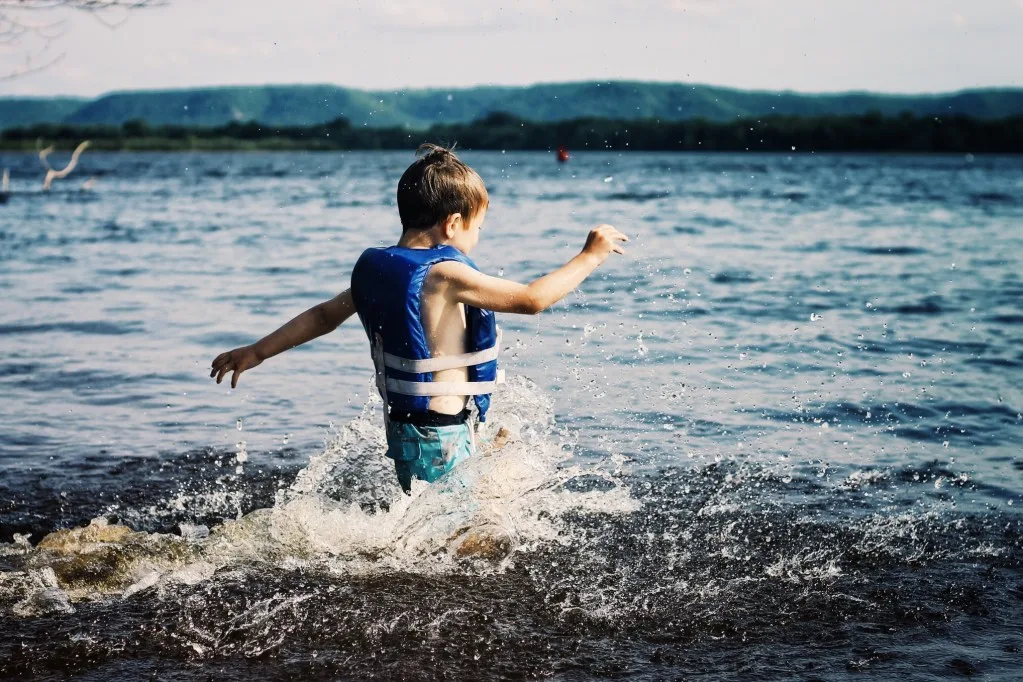Is it safe to swim in the Mississippi River? If you’re wondering what’s lurking beneath the murky surface of this iconic American waterway, you’re not alone.
While it might be safe for a quick dip, swimming in the Mississippi River is generally not recommended due to its high levels of pollution.
Keep reading to learn more about the mighty Mississippi River. It has changed over the years, making it a not-so-desirable swimming destination. However, it’s still a place of recreation – including swimming.
About the Mississippi River
The Mississippi River is one of the most iconic bodies of water in North America. It stretches all the way from its source in Lake Itasca in Minnesota down to the Gulf of Mexico. With over 2300 miles, it’s the second-longest river in the U.S., behind only the Missouri River.
It also ranks as the fourth-longest in the world, with the Yangtze, Nile, and Amazon Rivers laying claim to the three longest.
Named appropriately for its size from the Algonquin peoples, Misi-ziibi (meaning Great River), was later translated by the French into Messipi, ultimately becoming what we call it today – the Mississippi River.
This mighty river has been home to people since at least the 4th millennium BCE when Native Americans resided along the river. Later, European settlers came in and claimed sections of it for their nations. It wasn’t until the War of 1812, when the United States was victorious over Britain, that the Mississippi River fully belonged to the Americans.

Why Is the Mississippi River Important?
The Mississippi River is more than just a long river; it’s also one of the most important waterways in the United States. This is because the river serves as a main water source.
It’s a critical transportation route for businesses and industries that operate throughout the country. Launches and docks dot the banks of the Mississippi. They provide access to a wide array of goods and services for everyone from mega-corporations to small family-run businesses.
According to American Rivers, the Mississippi River is a $12.6 billion shipping industry and provides over 35,000 jobs.
The River’s Eco-System
The Mississippi River also supports a diverse range of plant life, attracting more than 400 different animal species. Major bird habitats are home to many creatures. They include bald eagles, osprey, great blue herons, muskrats, beavers, white-tailed deer, foxes, rabbits, and turtles. These animals provide endless opportunities for wildlife enthusiasts who flock to the Mississippi River areas to see them in their natural habitats.
Along with the wildlife and the wildlife enthusiasts, many outdoor enthusiasts also enjoy the waters of this iconic river. They come to paddle, fish, hunt, boat, and more within the waters or alongside the banks. Tourism and recreation along the river bring in over $20 billion annually and over 300,000 jobs. And because of all these opportunities and abundant wildlife, there are also seven National Park Service (NPS) sites along the Mississippi River’s immense stretch of surrounding lands.
In addition to its importance to the ecology of the U.S., the Mississippi River has also played a significant role in the country’s history and culture. Early Native American cultures were built along the river banks. Those banks were used as major transportation and trade routes. The river has also been immortalized in countless works of art, literature, and music, further cementing its place in American culture.
Pro Tip: While swimming, make sure to keep an eye out for these Most Dangerous Creatures in the Mississippi River.

What State Does the Mississippi River Run Through?
Spanning over 2,300 miles from its source in Minnesota to its mouth on the Gulf of Mexico, the Mississippi River runs through 10 different states. These states include Wisconsin, Iowa, Illinois, Missouri, Kentucky, Tennessee, Arkansas, Mississippi, and Louisiana, where it empties into the Gulf of Mexico just south of New Orleans.
Why Is the Mississippi River So Dirty?
The Mississippi River is one of the world’s greatest rivers, but it’s also one of the dirtiest. Every year, sewage and industrial waste enter the river. Farm runoff and urban runoff add even more pollution to the river. As a result, the river is often muddy and full of pollutants.
The Clean Water Act of 1972 has helped reduce pollution in the river over the years. However, this act focuses more on the point sources listed above and not on the non-point sources. Those being rainwater or snowmelt collecting pollutants as it runs over the land. In addition, floods often cause pollutants from floodplains to be washed into the river. This makes it even harder to keep the river clean.
Hence the color of the water, one might think. But contrary to popular belief, the Mighty Mississippi, often referred to as the Mighty Muddy, is not the brownish color due to only the pollutants entering the water. It is also because of the sediments entering the water as it flows down into the Gulf. Those sediments may include sand, silt, and clay, to mention just a few.
And where do these sediments come from? Some say most of these sediments actually come from the Minnesota River when it empties into the Mississippi. Sediments can come from natural terrain from eroding stream banks and runoff from farm fields and other businesses along the river banks.
Despite these challenges, many people still enjoy swimming, fishing, and boating in the Mississippi River.

Can You Swim in the Mississippi River?
While it’s more known for its commercial usage than as a popular swimming hole, you can swim in the river. And while you should be a bit concerned about the pollutant levels in certain areas along the river, you should also be highly aware of the currents.
The speed of the river varies depending on how high the waters are. An article in the MinnPost out of Minneapolis states, “When the river is lower, it might move around 2.5 feet per second, but 1 cubic foot of water weighs more than 60 pounds.” So when the water level is higher, the force is even stronger.
The key thing to remember about swimming in the Mississippi River is that it’s constantly changing. If you come prepared for that knowledge and you’re fine with that, swimming in the Mississippi can be a great experience. This is especially since it’s away from the cities and the fast-moving pace of the currents. So when you come across that gem of a swimming hole in the Mississippi River, will you jump in?
Pro Tip: After visiting the Mississippi River, make sure to check out These Mississippi Wineries Are Actually Good.
Can You Get Sick From Swimming in the Mississippi River?
And when you do jump in, should you be concerned about getting sick while swimming in it? Maybe, but plenty of people do still swim in the river. Keep in mind that while governmental agencies and clean water rules play a part in keeping the Mississippi River clean, it can still contain contaminants that may not be good for you.
According to the Mississippi Watershed Management Organization, “The Mississippi is still considered impaired for recreational use.” This means you could possibly get sick. Now, this is in the Twin Cities, so the water farther away from urban areas could have fewer pollutants. However, this is a river, and the same contaminants will continue to flow downstream, albeit possibly less.
So, yes, there is evidence of bacteria in the Mississippi River that could get a person sick. But this doesn’t mean that you can’t swim within its waters. It simply means you need to be more aware of what’s going on at the beaches along the Mississippi River. You’ll do that by researching ahead of time and following the signs posted before jumping in. And, bring your own drinking water.

How Deep Is the Mississippi River?
While the Mississippi River is not the deepest river in the U.S., it is the second deepest, only behind the Hudson River, which is at its deepest at around 216 ft. The average depth of the Mississippi is around nine feet, but its deepest point near Algiers Point in New Orleans is around 200 feet deep.
So while its deepest point is near its mouth, the widest point is closer to its source near Bena, Minn. That’s at Lake Winnibigoshish and measures more than 11 miles wide.
How Far Up the Mississippi River Can Ships Go?
The Mississippi River is one of the most important rivers in North America, serving as a major shipping route. For centuries, ships have been navigating the length of this iconic waterway, going further up the river with each passing year.
Today, ships can travel all the way up the river before reaching its headwaters in northern Minnesota. Of course, this journey depends on various factors such as ship sizes, water levels, and weather conditions.
However, thanks to careful planning and the use of cargo boats designed for these challenging conditions, ships can successfully navigate their way up the Mississippi River for hundreds of miles. Whether transporting goods or exploring uncharted territories, ships are truly taking advantage of all that this legendary river has to offer.
Is It Worth Swimming in the Mississippi River?
The Mississippi River is a well-known and iconic part of the U.S. It’s also one of the largest rivers in North America. It spans over 2,300 miles from its source in Minnesota to the Gulf of Mexico. So, it’s no surprise that many people want to know if swimming in this river is worth it.
Unfortunately, there isn’t a simple answer. While some sections of the Mississippi are clean and perfect for swimming, other parts are polluted and contain dangerous currents. If you decide to take a swim, be sure to check out water quality reports first to find a safe spot.
Will you jump into this iconic river? Tell us in the comments!
Discover the Best Free Camping Across the USA
To be honest with you, we hate paying for camping. There are so many free campsites in America (with complete privacy).
You should give it a try!
As a matter of fact, these free campsites are yours. Every time you pay federal taxes, you’re contributing to these lands.
Become a FREE CAMPING INSIDER and join the 100,000 campers that love to score the best site!
We’ll send you the 50 Best Free Campsites in the USA (one per state). Access the list by submitting your email below: